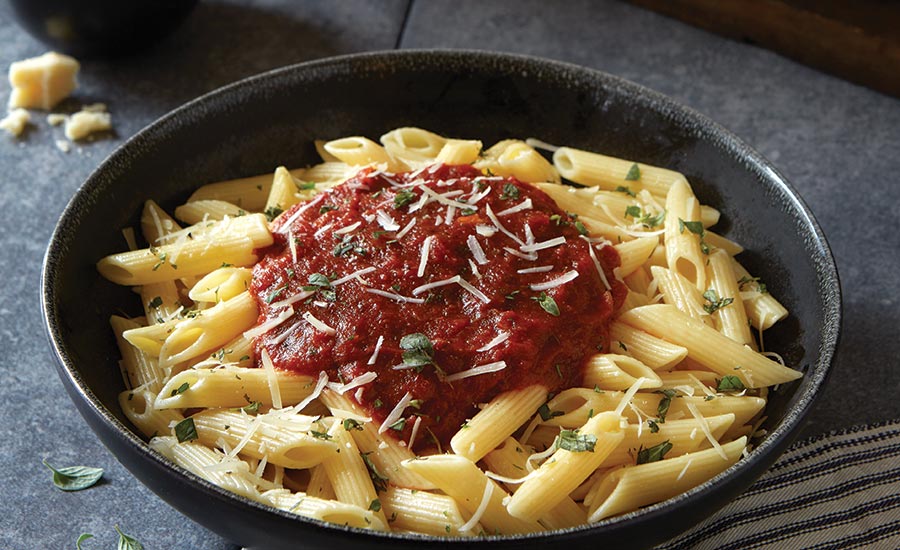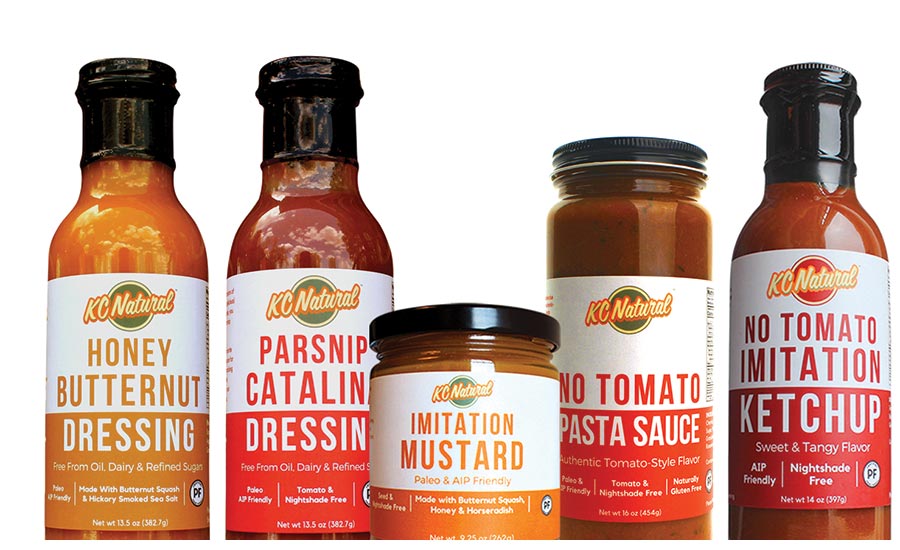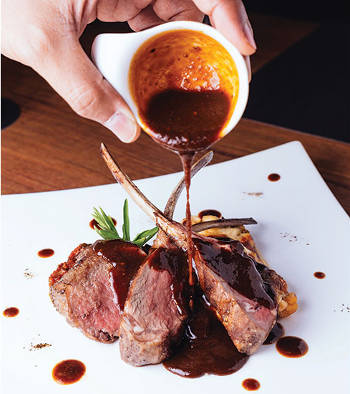Condiments and sauces historically have acted as wingmen, prompters, understudies, or rescuers of a food item. But with global flavor and health trends driving modern culinary creation, these former afterthoughts are more about building up, and even sharing the stage with, the objects of their intention.
Making food taste better or taste different is an ancient practice born of necessity. Spices, salt, alcohol, and vinegar preserved and protected food (especially animal and animal-derived products) and consumers from the negative effects and flavors of spoilage. With the advent of other means to protect food, sauces and condiments took on the role of enhancing otherwise bland or unexciting foods that were economical and utilitarian.
Soon enough, as the culinary arts grew, they began to center around sauces and condiments designed to showcase the items they served. Today, sauces and condiments are making bolder statements, taking more daring and expressive directions and asserting themselves as stars in their own right. Even basic tomato sauces are no longer generic but tout the tomatoes used, such as heirloom tomatoes.
Get Wet
While not exactly sauces or condiments, wet rubs are becoming quite popular in grilling and smoking platforms. Similar to a marinade, a wet rub is simply a dry rub to which a small amount of liquid is added. The liquid can be water, oil, juice, vinegar, beer, wine, a spirit reduction, or any other liquid of personal preference. Wet rubs are best used on foods that are going to be grilled or roasted for long periods of time, such as meat or poultry. The flavors penetrate the outer layer of the item, while the spices and herbs leave the meat or poultry with a nice crust without drying out. Wet rubs are best when rubbed vigorously into the product and then the product is wrapped in plastic wrap and stored in the refrigerator for several hours or overnight. Makers of wet rubs are providing them as a complete product or in component packages for the consumer to combine.
Exemplifying the direction of sauce trends would be B&G Foods Inc.’s Victoria Fine Foods brand. In recent years, the 80-year-old pasta sauce maker has expanded its line-up to include sauces such as avocado oil marinara, Chianti marinara, white bean marinara, artichoke Alfredo, and an arugula pesto Alfredo.
Other companies have released sauces that, while based on highly regional traditions in their countries of origin, would have been unheard of on store shelves even a few years ago: pumpkin and butternut squash sauces for pasta, for example. And from there, it has been a short leap to fusions, such as one company’s recent launch of a pumpkin-chipotle pasta sauce.
Barbecue sauces, too, have seen a dramatic expansion in varieties and choices, including those incorporating fruits (apricot, peach, pineapple, and mango being common), spirits, ghost peppers, and balsamic vinegar. Of course, barbecue sauce makers also have embraced the global flavors trend with products based on sauces from Thai, Korean, Cantonese, and other cuisine traditions.
The explosion of cooking sauces for a quick heat-and-eat meal can certainly be said to have begun with pasta sauces. And while the recent rapid expansion of brands and offerings in the pasta sauce category occupies entire walls at retail supermarkets, the simmer sauce revolution now encompasses the whole planet. The trend has expanded to include everything from Thai and South Asian Curries to Korean Stir-fry sauces to Middle Eastern tagine sauces. It amply demonstrates the best of convenience and gourmet attractions for today’s consumers.
Special Needs
In addition, sauce makers have plunged in to meet such demand-based trends as organic, gluten-free, non-GMO, and allergen-free. Such moves have necessitated closer attention to ingredients and their sources, going beyond edgy and unusual flavors and textures to sometimes compensating for the flavor impact such formulation or reformulation can have.
“One of the biggest challenges in the sauce and dressing area is making products taste great while following their customers’ direction of reducing salt, fat, sugars and calories,” says Ellen Powell, CFS, director of Giraffe Foods Ltd. The Canadian company is a developer and manufacturer of private label sauces, marinades, dips, and dressings.

Modified non-GMO wheat starches make excellent thickeners, being tolerant to shear, low pH, and high-temperature processing, as well as stable in refrigerated/ frozen conditions.
PHOTO COURTESY: MGP Ingredients, Inc. (www.mgpingredients.com)
“Great-tasting products come from a balance of the five basic flavor profiles—salty, sweet, acidic, bitter, and umami,” Powell points out. “When you start removing and altering that balance, the ultimate flavor goal is more difficult to achieve.” The hurdles are even greater when developing sauces and condiments for consumers with certain allergies or sensitivities.
While meat demi-glaçe is the classic source of a good strong umami flavor base, the trend toward vegetarian/vegan foods knocks it out of the running. Imparting umami into vegetarian sauces can come from such sources as malted grains, mushroom extracts, yeast extracts, and tomato concentrates (pastes or extracts). One of the most versatile sources of umami is soy sauce.
Hot Stuff
Among all recently launched sauces and condiments, one of the biggest trends is heat. “The hotter the better,” exclaims Jeff Cousminer, a long-time product developer for retail and foodservice establishments and a past president of the Research Chefs Association. Cousminer cites another popular trend: combining hot chili peppers with fruit in sauce, condiment, and glaze formulations. “There is a growing number of barbecue sauces and other sauces blending, for example, pineapple and habanero,” he says.
Having worked for a number of flavor houses and condiment makers, Cousminer has witnessed the rapid climb of popularity—and heat levels—in the hot chili peppers used in product development. The newest and most surprising are the two hottest chili peppers commercially available, the Indian Ghost Pepper (Bhut jolokia) at around 500,000 Scoville Heat Units (SHU), and the Scorpion Pepper at 1.5-2.2 million SHU. (For comparison, tactical pepper spray is around 2 million SHU.)
“Consumers see the Ghost chili in the popular media and it becomes a challenge,” says Cousminer. “They think, ‘Hey, I’ve survived sriracha and habaneros—now I have to conquer the Ghost.’”
In consulting on projects using super-hot peppers, Cousminer notes that, “One of the biggest items on everyone’s mind is safety for the plant workers.” In addition to the usual precautions of wearing gloves, working on dedicated surfaces with dedicated utensils, washing tools and hands thoroughly after prep, and avoiding touching any exposed skin (especially the eyes), Cousminer adds the following production tip: “We learned that rinsing cooking vessels with cold water instead of hot reduced the airborne capsaicin—the volatile component of the hot chili pepper.”
Soy sauce can add body and depth to savory sauces while keeping them strictly animal-free. Research chefs have been discovering the benefit of soy sauce for formulations that are not rooted in any Asian cuisine. The flavor notes from fermented soy match well with any hearty sauce or condiment formulation, such as Southwestern, Latin, and even Middle Eastern.
Fody Foods Inc. is a cross-category manufacturer of “low FODMAP” products for people suffering from Irritable Bowel Syndrome (IBS). FODMAP is the acronym for the foods that an individual with IBS should avoid: Fermentable Oligosaccharides, Disaccharides, Monosaccharides, and Polyols. These are short- and medium-chain carbohydrates, plus sugar alcohols, are found in commonly eaten foods such as pasta, bread, onions, garlic, beans, milk, apples, honey, and mangoes.
The low FODMAP diet for IBS was first defined in 2004 by researchers at Monash University, Australia. It categorizes foods that trigger gastrointestinal problems according to the type of carbohydrate they contain. This makes it possible to systematically test one group of food at a time, instead of individual items.
However, the list of foods that cause irritation and need to be avoided is mind-boggling. “One of the biggest challenges to developing great-tasting condiments and sauces is to make them without onions or garlic,” says Steve Singer, founder and CEO of Fody. “These are among the two major contributors to IBS.”
All of Fody’s products are low-FODMAP. A great deal of knowledge of the nutritional aspects of raw materials is needed, as the afflicted population has multiple levels of sensitivity.
Some persons can be more susceptible to fruits; others might be more susceptible to the vegetables and legumes. Even then, there are other ingredient considerations. “Using a banana in development is okay if it is green, as it will be low-FODMAP,” explains Singer. “However, if a banana is yellow, that’s a ‘no go’.”
While learning about autoimmune disease and chronic illness, Brendon O’Neill, owner of KC Natural LLC, discovered the “Paleo AIP elimination diet” which excludes all nightshades. “I started KC Natural after experiencing my own autoimmune and food allergy issues,” says O’Neill. “Being from Kansas City, I love BBQ and wanted to create sauces that were clean of common allergens, as well as refined sugars.”
Finding no retail options for the followers of this diet, O’Neill crafted a complete line of first-to-market nightshade-free products. “For first-to-market products like these, there really isn’t a roadmap,” says O’Neill. “When I tried developing recipes from other sources, nothing tasted authentic. So I had to build everything from scratch, focusing on ingredients that had similar flavor profiles and textures but that were common and easily sourced.”
Since they were launched, KC Natural sauces and condiments have become some of the most popular condiments within the Paleo channel, and the company is seeking partners to expand national distribution.
“We launched the first seed-free mustard, made with butternut squash, honey, and horseradish root,” notes O’Neill. “However, our ‘No Tomato’ pasta sauce is our most popular item. Even people who can eat nightshades can’t tell it is made without tomatoes.”
A Dab’ll Do Ya’
Condiments are experiencing a similar explosion of variety. A generation ago, there was only a handful of ketchups, mustards, mayonnaises, or hot sauces to choose from.
Today, thousands of each type of said condiments not only line supermarket shelves but also, in some cases, are an industry in their own right. For example, there are entire stores devoted solely to hot pepper sauces.

Sweet sauces are trending high with popular fusions ranging from salted
caramel to chocolate with chili peppers and even comfort favorites that pair chocolate with fruit.
PHOTO COURTESY: Lyons Magnus Inc. (www.lyonsmagnus.com)
Ketchup remains near the top of the list of most-used sauces. A unique twist on ketchup that has been rapidly gaining popularity is a Filipino condiment called “banana ketchup.” It looks and tastes like a tomato ketchup; however, it is made with bananas, sugar, vinegar, spices, and red food color. It was developed during World War II when the year 1942 saw a lack of tomatoes and a simultaneous abundance of bananas in the Philippines.
Ketchup and other condiments, although used in much smaller amounts than sauces, are being impacted by various health and “free from” trends. Many companies are producing condiments that are gluten-free, clean-label, or made of non-GMO ingredients. In addition to its pasta sauces, KC Naturals LLC makes nightshade-free mustard, ketchup, dressings, and barbecue sauces.
Many companies have decided to opt out of high-fructose corn syrup. They typically replace it with sucrose in the form of cane sugar or brown sugar. Best Foods Inc. recently launched a ketchup that is sweetened with honey and contains only five other ingredients.
Some companies opt to sweeten their products only with fruit. Raisin syrup and fig syrup are two fruit sweeteners that developers can look to for such reformulations, as those sweeteners add extra depth and body to a condiment or sauce.
Using fruit as a sweetener for barbecue sauces, dressings, savory sauces, and condiments is not new, of course, but developers have been expanding the range of fruits they choose to use. Berries, especially blueberries, have attracted interest recently as components of sauces.
Blueberry formats available for sauce makers include fresh, frozen, infused, concentrated, and dried, as well as in juice and purée form. Blueberries not only add sweetness and flavor, they also contribute to color and texture. As a natural source of pectin, they can sit in for added thickeners in a formulation, allowing for a cleaner and shorter label.
Pour it On! Spread the News!
Sauces and spreads shine in “SRG StreetDive” at Prepared Foods’ New Products Conference
Prepared Foods hosted its 36th annual New Products Conference last fall in downtown Minneapolis. Among featured activities was an evening “SRG StreetDive” taste-the-trends group outing led by Sterling Rice Group (SRG) and sponsored by tastepoint by IFF, a flavors company.
Approximately 80 NPC attendees toured The Wedge Lyndale, one of three retail grocery outlets managed by Twin City Co-Op Partners. Managed by CEO Josh Resnik, The Wedge is widely regarded for showcasing emerging food and drink companies and their products across all retail and in-store categories.
For the SRG StreetDive, five local company entrepreneurs came in to provide product samples and meet conference attendees. Among those sampling as KC Kye, the CEO of K-Mama Sauce, LLC (www.kmamasauce.com), a Minneapolis, maker of Korean hot sauce. Meanwhile, Resnik and SRG planners also created an in-store scavenger hunt for attendees to “discover” various manufacturer-vendors. There were three additional spread and sauce products, including:
- Porcini Spread from Cherry Tree House Mushrooms, Clayton, Wis.
Visit: www.cherrytreehousemushrooms.com - Harissa-Saffron Spread from Grlk, St. Paul, Minn
Visit: www.grlksauce.com - Chocolate Avocado Spread from D’Avocado LLC, Minneapolis
Visit: www.fromtheavocado.com
Curious Yellow
Mustard is one of the world’s oldest condiments. In Roman times, ground seeds were mixed with grape juice must to make a hot paste called mustum ardens, or “burning must.” Little has changed in the basic production since mustard was introduced to the modern world.
The level of heat and variety of mustard depends upon the type of seed used and the liquid with which the ground or broken seeds are blended. Mild mustards typically consist of ground yellow mustard seed blended with vinegar. More pungent mustards are made with black or brown seeds and blended with water.

Sauce and condiment makers meeting demand-based trends like organic, gluten-free, non-GMO, and allergen-free are stretching their creativity to compensate for the flavors and textures of the traditional versions.
PHOTO COURTESY: KC Natural Products Inc. (www.kcnatural.com)
Mustard seeds themselves have no heat on their own until their oils are volatized via the enzymatic reaction that occurs when they are when blended with liquid. The more acidic the liquid, the more slowly the enzyme reacts to create the heat. The less acidic a liquid, the quicker the reaction.
The temperature of the liquid will also affect the enzyme reaction. Hot water will deactivate some of the enzymes and break down the compounds that create the heat and pungency. Cold water allows the reactive compounds to remain intact. In both cases, the heat reaction will stabilize—however, at different rates—and the pungency will diminish over time.
Mustards have experienced an explosion in creativity and innovation in recent years, with hundreds of flavor options and inclusions ranging from sweeteners such as honey, fruit, or maple to various wines, vinegars, beer, and spirits, to ramping up the heat with chili peppers such as habanero and scorpion peppers.

Wine, beer, and spirit reductions, while classic components of sauces, have broadened to include a variety of modern favorite flavors, such as whiskey, stout,
and others.
PHOTO COURTESY: Mizkan Food Co. (www.mizkan.com)
Ketchup and mustard are combining with each other and with other condiments, such as sriracha and even mayonnaise. Last spring, the Kraft Heinz Co. launched its “Mayochup Saucy Sauce,” a smooth, squeezable marriage of Heinz classic ketchup and Kraft mayonnaise. While a “comfort food condiment” more than a trend-setter, the instant popularity of this new release demonstrates that condiments, sauces, and dressings as a category are appealing to consumers on a whole new level.
This growing trend in condiments and sauces for the table has embraced other popular sauces to use as a platform for an expanse of flavors. Even gochujang is now a springboard for saucy fusions. Companies such as CJ Foods Inc.’s “Bibigo” line of Korean sauces and condiments uses the popular Korean hot sauce to create such combos as Gochujang Mayo, Gochujang Barbecue Sauce Glaze, and a Gochujang Hot & Sweet sauce. With no limits on creativity, the trend is likely to continue to grow.
“Saucy” Stats and Flavor Forecast
by Susan Cohen for Datassential Market Research Inc.
Market research group Datassential released its latest new SNAP! Keynote, “Sauces, Condiments, Dips & Dressings.” In it, the group looks at how sauces and condiments have been trending in the past several years and forecasts growth of those flavors and products for the coming years. Here’s what their saucy crystal ball is showing.
Gochujang: Gochujang brings a spicy and sweet flavor to Korean foods while progressive chefs are adding it to everyday items. Datassential Haiku, an AI trends forecasting platform, projects that gochujang will grow 98% on restaurant menus over the next four years.
Sriracha aïoli: This sauce combines two popular and growing ingredients, sriracha and aïoli. It’s one of several aioli sauces on menues beyond the traditional garlic version. Its primary flavor, the Thai hot sauce sriracha has grown on menus by 170% over the past four years.
Green Goddess Dressing: The creamy salad dressing is traditionally used on California-inspired salads and has made a comeback on menus after being a popular dressing in the 1970s. It is a versatile ingredient being used beyond salads as a dip for veggies or a sandwich spread. Datassential Haiku predicts it will continue its growth by 34% over the next four years.
Bacon Jam: Part of the growing popularity of savory jams, bacon jam is one of the fastest growing sauces on menus. There is still room for growth for bacon jam – just 13% of consumers say they’ve tried it. It’s mostly added to burgers and is also found on hot sandwiches and with appetizers. Other savory jams include onion jam, tomato jam, and pepper jam.
Chimichurri: This bright green condiment made from fresh parsley, garlic, olive oil, and more is ubiquitous in Argentina and primarily used on grilled meats. The sauce is mentioned on 7% of US menus, up 83% over the past four years.
The group also points to a few other sauces to keep on the radar:
Harissa
Penetration growth: +42% over the past four years
Predicted growth: +24% over the next four years
Romesco
Penetration growth: +90 over the past four years
Predicted growth: +26% over the next four years
Tahini
Penetration growth +41% over the past four years
Predicted growth: +18% over the next four years
To find out more about Datassential’s new SNAP! Keynote: Sauces, Condiments, Dips & Dressings, contact Susan Cohen at susan.cohen@datassential.com or (312) 219-6428.
Originally appeared in the January, 2019 issue of Prepared Foods as Pour it On.





